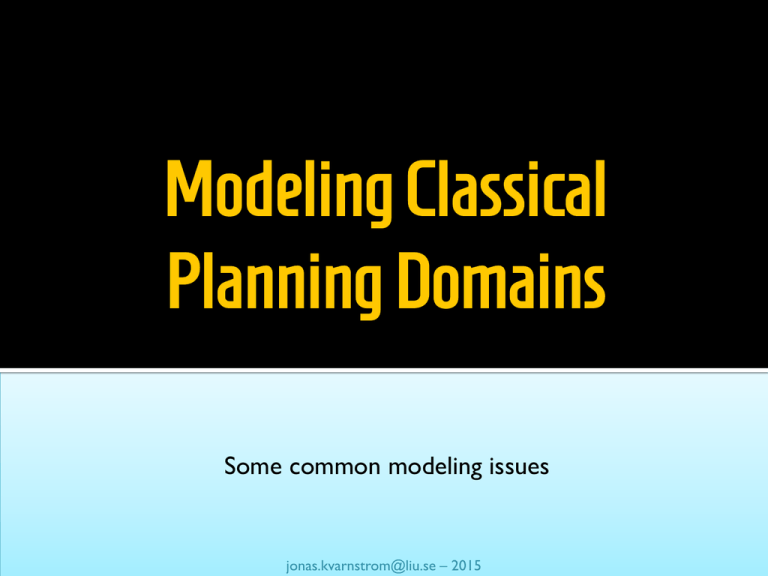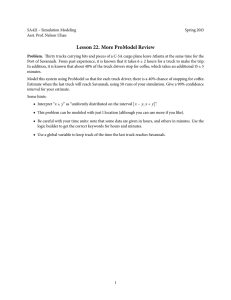Modeling Classical Planning Domains Some common modeling issues – 2015
advertisement

Modeling Classical Planning Domains Some common modeling issues jonas.kvarnstrom@liu.se – 2015 Consider modeling a ”drive” operator for a truck ”Natural” parameters: The truck and the destination ▪ (:action drive :parameters (?t – truck ?dest – location) :precondition … :effect … ) ”Natural” precondition: ▪ There must exist a path between the current location and the destination ▪ Should use the predicate (path-between ?loc1 ?loc2 – location) ▪ State variable representation can express the location of the truck: (:precondition (path-between (location-of ?t) ?dest)) ▪ But in a first-order predicate representation, we can only test whether a truck is at some specific location: (at ?t ?location) 3 jonkv@ida Property Values 1 Standard solution: Add a parameter to the operator ▪ (:action drive :parameters (?t – truck ?from – location ?dest – location) :precondition … :effect … ) Constrain that variable in the precondition ▪ :precondition (and (at ?t ?from) (path-between ?from ?dest)) ▪ Can only apply those instances of the operator where ?from is the current location of the truck 4 jonkv@ida Property Values 2 Example: Initially: ▪ (at truck5 home) 5 These parameters are "extraneous" in the sense that they do not add choice: We can choose truck and dest (given some constraints): from is uniquely determined by state + other params! Action: ▪ (:action drive :parameters (?t – truck ?from – location ?dest – location) :precondition (and (at ?t ?from) (path-between ?from ?dest)) :effect … ) Which actions are executable? ▪ (drive truck5 work home) – no, precond false ▪ (drive truck5 work work) – no, precond false ▪ (drive truck5 work store) – no, precond false ▪ (drive truck5 home store) – precond true, can be applied! With quantification, we could have changed the precondition: (exists (?from – location) (and (at ?t ?from) (path-between ?from ?dest)) No need for a new parameter – in this case… jonkv@ida Property Values 3 6 What about effects? Same ”natural” parameters: The truck and the destination ▪ (:action drive :parameters (?t – truck ?dest – location) :precondition … :effect … ) ”Natural” effects: ▪ The truck ends up at the destination: ▪ The truck is no longer where it started: (at ?t ?dest) (not (at ?t …???... )) How do you find out where the truck was before the action? ▪ Using an additional parameter still works: (not (at ?t?from)) ▪ The value of ?from is constrained in the precondition – before ▪ The value is used in the effect state jonkv@ida Property Values 4 8 We often need at least some ”primitive” support for counting Elevator domain: ▪ Which floor is an elevator at? ▪ Which is the next floor? ▪ Which is the previous floor? Few planners support general numeric state variables jonkv@ida Counting 1 9 Standard solution: Create a type of ”pseudo-numbers” ▪ (:types … num …) Define a set of value objects ▪ (:objects … n0 n1 n2 n3 n4 n5 n6 n7 – num) Define the operations you need – for example, find the next number ▪ (:predicates … (next ?numA ?numB – num) ▪ (:init … (next n0 n1) (next n1 n2) (next n2 n3) … (next n6 n7)) Use the value objects as if they were numbers These are also ▪ (:action move-up "extraneous" parameters… :parameters (?e – elevator ?from ?to – num) :precondition (and (at ?elevator ?from) ;; Where is the elevator? (next ?from ?to) …) ;; Now ”to” is the next number :effects (and (not (at ?elevator ?from)) (at ?elevator ?to))) There is no ”next” for n7 Won’t be able to move up from the top floor (an "implicitly modeled" precondition) jonkv@ida Counting 2 11 Some planners lack support for explicit types Constants are untyped, operators have untyped parameters, … Consider an untyped operator in the Logistics domain: ▪ (:action load-truck :parameters (?obj ?truck ?loc) :precondition (and (at ?truck ?loc) (at ?obj ?loc)) (and (not (at ?obj ?loc)) (in ?obj ?truck))) :effect This is a valid instance of that action: ▪ (load-truck truck1 truck1 loc2) ;; Truck1 loads truck1 at location loc2 So how do we ensure an untyped planner never uses that action? jonkv@ida Untyped Domains 12 Standard solution: Preconditions use type predicates Ordinary predicates that happen to represent types: ▪ (:predicates (OBJ ?x) (TRUCK ?x) (AIRPLANE ?x) (CITY ?x) (at ?x ?y) (in ?x ?y) (LOCATION ?x) (AIRPORT ?x) (in-city ?x ?y)) Initialized in the problem instance: ▪ (:init (OBJ package1) (OBJ package2) … Used as part of preconditions: ▪ (:action LOAD-TRUCK :parameters (?obj ?truck ?loc) :precondition (and (OBJ ?obj) (TRUCK ?truck) (LOCATION ?loc) (at ?truck ?loc) (at ?obj ?loc)) :effect (and (not (at ?obj ?loc)) (in ?obj ?truck))) Since we don’t have ”real” types: ▪ load-truck(truck1, truck1, loc2) is still a valid action ▪ Doesn’t matter: Its preconditions can never be satisfied in reachable states! ▪ OBJ, TRUCK and LOCATION are static (never modified) such actions can be ignored by all planners jonkv@ida Untyped Domains (2) 13 What about Dock Worker Robots? Shown in an earlier lecture Did not have explicit type predicates: ▪ take(k, l, c, d, p): ;; crane k at location l takes container c off container d in pile p precond: belong(k,l), empty(k), attached(p,l), top(c,p), on(c,d) effects: holding(k,c), ¬empty(k), ¬in(c,p), ¬top(c,p), ¬on(c,d), top(d,p) This is a valid instance of that action: ▪ take(c3, crane1, r1, crane2, r2) ;; Container c3 at location crane1 takes robot1 off crane2 in pile robot2 Was the DWR specification wrong? jonkv@ida Untyped Domains (3) 14 What’s important: Given arguments of the wrong type, the precondition is false! ▪ take(k, l, c, d, p): ;; crane k at location l takes container c off container d in pile p belong(k,l), empty(k), attached(p,l), top(c,p), on(c,d) precond: effects: holding(k,c), ¬empty(k), ¬in(c,p), ¬top(c,p), ¬on(c,d), top(d,p) ▪ The precondition requires belong(k,l): (belong ?k - crane ?l - location) ; crane ?k belongs to location ?l ▪ In any "reasonable" initial state, this is only true if k really is a crane ▪ Since belong is static, this will remain true in all reachable states jonkv@ida Untyped Domains (4)





